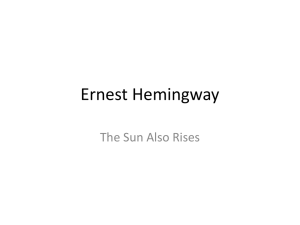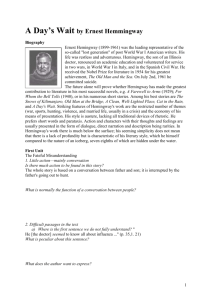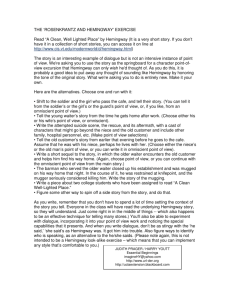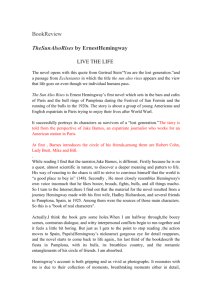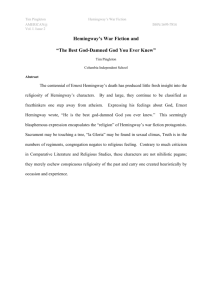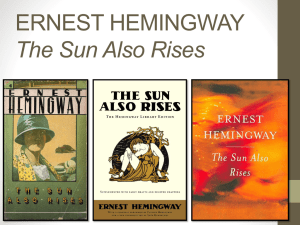Name IB Candidate Code Written Task Category 1, Part 1
advertisement
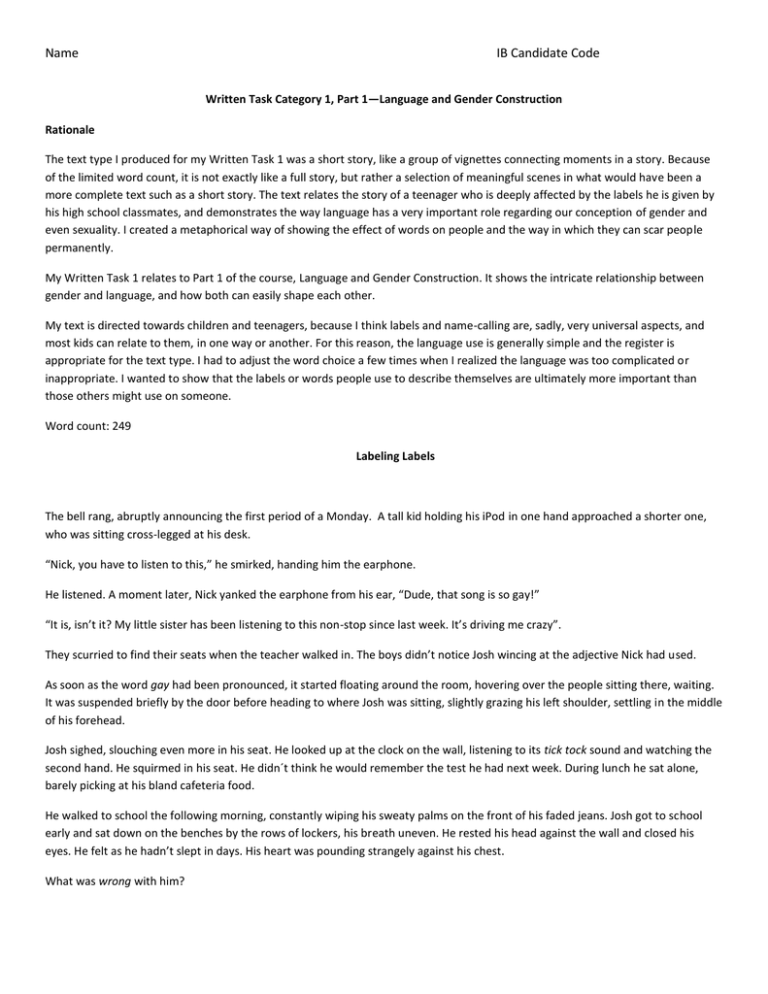
Name IB Candidate Code Written Task Category 1, Part 1—Language and Gender Construction Rationale The text type I produced for my Written Task 1 was a short story, like a group of vignettes connecting moments in a story. Because of the limited word count, it is not exactly like a full story, but rather a selection of meaningful scenes in what would have been a more complete text such as a short story. The text relates the story of a teenager who is deeply affected by the labels he is given by his high school classmates, and demonstrates the way language has a very important role regarding our conception of gender and even sexuality. I created a metaphorical way of showing the effect of words on people and the way in which they can scar people permanently. My Written Task 1 relates to Part 1 of the course, Language and Gender Construction. It shows the intricate relationship between gender and language, and how both can easily shape each other. My text is directed towards children and teenagers, because I think labels and name-calling are, sadly, very universal aspects, and most kids can relate to them, in one way or another. For this reason, the language use is generally simple and the register is appropriate for the text type. I had to adjust the word choice a few times when I realized the language was too complicated or inappropriate. I wanted to show that the labels or words people use to describe themselves are ultimately more important than those others might use on someone. Word count: 249 Labeling Labels The bell rang, abruptly announcing the first period of a Monday. A tall kid holding his iPod in one hand approached a shorter one, who was sitting cross-legged at his desk. “Nick, you have to listen to this,” he smirked, handing him the earphone. He listened. A moment later, Nick yanked the earphone from his ear, “Dude, that song is so gay!” “It is, isn’t it? My little sister has been listening to this non-stop since last week. It’s driving me crazy”. They scurried to find their seats when the teacher walked in. The boys didn’t notice Josh wincing at the adjective Nick had used. As soon as the word gay had been pronounced, it started floating around the room, hovering over the people sitting there, waiting. It was suspended briefly by the door before heading to where Josh was sitting, slightly grazing his left shoulder, settling in the middle of his forehead. Josh sighed, slouching even more in his seat. He looked up at the clock on the wall, listening to its tick tock sound and watching the second hand. He squirmed in his seat. He didn´t think he would remember the test he had next week. During lunch he sat alone, barely picking at his bland cafeteria food. He walked to school the following morning, constantly wiping his sweaty palms on the front of his faded jeans. Josh got to school early and sat down on the benches by the rows of lockers, his breath uneven. He rested his head against the wall and closed his eyes. He felt as he hadn’t slept in days. His heart was pounding strangely against his chest. What was wrong with him? Name IB Candidate Code One autumn morning, Josh sat in the living room in his pajamas, playing with his sister’s Barbie dolls. He was dressing Barbie in a pink outfit when he heard steps descending the stairs. His dad was standing in his black robe and slippers. “No boy of mine is going to behave like a sissy in my house,” his father’s voice was low and husky. Josh remembers his dad shouting at him, his mom coming down from the second floor, saying “He is only seven!” and then his dad spanking him, then stuffing the dolls into a bag, and then his mom hugging him. He woke up several hours later. His Star Wars pillow case was damp with his tears. The covers were stained with the word sissy, and so was Josh’s body. He rubbed his faced and shook his bed linen, making the Ss and Ys and Is somersault and tumble in the air and then land on the rug. He looked around at the decoration in his room. The wallpaper had red and blue cars. His shelves were lined with small plastic soldiers, miniature cars, his Star Wars models. The toy boxes contained brightly colored Lego bricks and his baseball bat was in the corner. The teddy bear he received the day he was born was on the top shelf: IT’S A BOY! He knew these words and letters were also printed all over his skin, tiny baby blue letters that were impossible to wash out. Josh dragged his feet as we walked to the gymnasium, the letters spilling behind him, lots of Gs, and Fs and Ys leaving a trail in the halls where he had seen so many labels printed on kids’ backs as if they were the tag for brands of clothing that needed to be shown. The word bitch was scrawled on top of a locker, while slut, fag and loser lay in puddles beneath the water fountain. He stepped on them, crushing a small blue gay that had fallen off his back. He broke the G into pieces with his fingers and crushed the letters in his closed fist. The words were scattered at the bottom of his backpack and sprayed on his face each time somebody insulted him. He walked into the men´s locker room, watching his classmates snicker as he made his way towards his locker. He looked up and saw something that made him stop in his tracks. He dropped his backpack at his feet. The word FAG was scrawled in pink, bold graffiti letters on his locker. His heart sank. He turned around and made his way for the door, but a muscular guy blocked his way. He ducked before they could get him and ran and ran, the letters and words right behind him, chasing him, gay, fag, sissy, every single word he’d ever been called clinging to the cuff of his jeans, to his hoodie, to the pockets of his shirt. So he just ran. A month had passed. The letters covered everything he touched. They seemed to be inside his head and blur his vision, revolving around him like a cluster of mad bees. But he wasn´t going to take it anymore. He started picking the letters and words out of his pajama pockets, removing them from his tangled hair, scraping them from his skin and clothes and placing them in a bag. He cleaned his room, making sure that no letter or word was hiding, waiting to become tattooed on his skin. He retrieved fag and gay from his left shoe. He removed only five letters from the bag and put them in his pocket as we walked up to the toilet. He shoved the remaining contents in the toilet bowl and watched as they vanished in a tornado. He decided that labels were for clothes, not people. But if he was going to endure the burden of words, then there was only one thing he considered himself to be. Name IB Candidate Code He arranged his five letters on his desk, putting them in the right order. They floated around the room for a minute before forming the word he had spelled and then settled on his forehead: HUMAN. Word count: 980 Written Task Category 2, Part 4: Literature – Critical Study: The Sun Also Rises Subject: English A1: Language and Literature Level: High Candidate name: Candidate Session Number: 0 0 0 9 0 7 0 0 Prescribed question chosen Text and genre: How does the text conform to, or deviate from, the conventions of a particular genre, and for what purpose? Title of the text(s) for analysis: The Sun Also Rises by Ernest Hemingway Part of the course to which the tasks refers: Part 4: Literature—Critical Study The task focuses on the way dialogue is used as a way of indirect characterization in the novel, noting the specific elements in Hemingway´s style regarding dialogue. The way the dialogue is constructed leaves a lot implicitly stated in the text: the main example is the reference to Jake´s injury in war. He does not reveal this detail directly to the reader, but instead it is vaguely mentioned during conversation he has with Brett. The themes gradually revealed through dialogue unfold as the plotline advances, and they relate directly to the major themes present in Modernist writing as a result of the World War I. Written Task Category 2, Part 4: Literature – Critical Study: The Sun Also Rises “I Say”: Ernest Hemingway´s Modernist Dialogue and Indirect Characterization Verisimilar literary dialogue is an instrument for bringing a text to life as it attempts to resemble reality without being an actual transcription of it. Besides action, dialogue is the strongest way of showing the interaction that characters are capable of having with each other: what they say and how they say it (Bowen as mentioned in Lamb 454). Ernest Hemingway has been at times referred to as the master of dialogue, and his 1926 novel The Sun Also Rises clearly demonstrates the way in which he employed dialogue to characterize and reveal details and to advance the plotline. Former editor of the Times Literary Supplement, Alan PryceJones, proclaimed there was “not a . . . writer . . . who has been unaffected by the laconic speed of [Hemingway´s] dialogue, the Name IB Candidate Code subtle revelation of character that lies behind a spoken phrase” (as cited in Lamb 453). Hemingway has created a turning point in modernist writing with his language and dialogue use, especially when contrasted with some of his contemporaries. Indirect characterization through dialogue in Ernest Hemingway´s The Sun Also Rises provides a subtle way of unraveling and presenting characters by using repetition and adding particular effects to the conversation, such as the omitted identification of speakers, the italicized stresses and the verisimilitude of the speech. There are numerous characteristics that make Hemingway´s dialogue unique and distinctive in the way he employs it to reveal characters and advance plot. He has a proclivity of arranging medium and short—and at times extensive—conversations in scenes where the dialogue is balanced out with description and action. However, Hemingway deliberately omits the usual character dialogue tags that identify the speakers. As a result, the reader must remain even more attentive to the way the conversation is developing, especially when the exchange is occurring between more than two people. In addition, he does not attempt to be overly creative with the character tags in dialogue. Hemingway limits his use to the traditional “he/she said”, thus directing the attention towards the conversation itself and not towards other more distracting words such as “ she/he smiled, croaked, and mumbled”. Lastly, repetition is used consistently throughout the novel, not only in the content of the dialogue, but also in the way certain characters speak. The most noticeable example of this is Brett and Mike´s (and other characters´ as well) identifying tag “I say” before addressing anyone, or commenting during a conversation. It is through passages containing dialogue that the reader learns about certain aspects of the characters, elements that the narrator Jake does not tell the reader directly. For instance, it is implicit in the novel that Jake has suffered a war injury that has left him physically and figuratively emasculated. Jake, or course, does not state: “I cannot have sex with Brett, though we are both deeply in love with each other. Thus, our relationship is truncated and destructive.” Instead, Hemingway reveals Jake´s condition through a vague conversation between Jake and Brett, while riding in a taxi cab in chapter four: “Don´t touch me,” she said. “Please don´t touch me.” “What´s the matter?” “I can´t stand it.” “Oh, Brett.” “You mustn´t. You must know. I can´t stand it, that´s all. Oh, darling, please understand!” “Don´t you love me?” “Love you? I simply turn to jelly when you touch me.” “Isn´t there anything we can do about it?” Name IB Candidate Code [. . .] "When I think of the hell I’ve put chaps through. I’m paying for it all now." "Don’t talk like a fool," I said. "Besides, what happened to me is supposed to be funny. I never think about it." "Oh, no. I’ll lay you don’t." "Well, let’s shut up about it." "I laughed about it too, myself, once." She wasn’t looking at me. "A friend of my brother’s came home that way from Mons. It seemed like a hell of a joke. Chaps never know anything, do they?" "No," I said. "Nobody ever knows anything." (Hemingway 33-35) This conversation, in turn, relates to one of the novel´s main themes: male insecurity. It seems as if Jake—and most male characters—are constantly attacking Robert Cohn because they feel as though they should prove something to themselves about their own seemingly weakened masculinity and roles. With similar scenes and conversations, the theme of masculinity and feebleness is gradually, masterfully unraveled as the reader begins to comprehend the implications and consequences of the war, and the way it scarred—both literally and symbolically—the characters who meander aimlessly through the 1920´s Parisian bars. Lastly, the way in which indirect characterization through dialogue is used in Hemingway´s The Sun Also Rises forces the readers to “read between the lines”, to interpret what has been left openly undeclared and what has been seemingly obscured. The crafting of realistic, believable dialogue is an art, and Hemingway has masterfully used it to epitomize the portrayal of shadowy, somewhat murky characters, marked by the aftermaths of the Great War. Lamb quotes Macauley & Lanning in his article “Hemingway and the Creation of Twentieth- Century Dialogue”, corroborating that “speech, as a way of characterization, moves forward by means of partial concealment, partial exposure” (as cited in Lamb 455). How exactly can a reader determine that The Sun Also Rises is the quintessential novel of the Lost Generation, and its irremediable purposelessness? How can the reader tell it is part of the modernist literary movement? Dialogue in the novel serves the purpose as it conforms to the conventions of modernist writing, as well as diverging from it: the utter simplicity of Hemingway´s language embodies the ideal of saying a lot with what is only apparently scarce. Word count: 941 Hemingway, Ernest. The Sun Also Rises. New York: Scribner, 1926. Print. Lamb, Robert Paul. “Hemingway and the Creation of Twentieth-Century Dialogue.” Twentieth Century Literature 42.2(1996): 453. Advanced Placement Source. Web. 7 Mar. 2013 *This writer had the proper Works cited but I minimized it to make the pages less.
